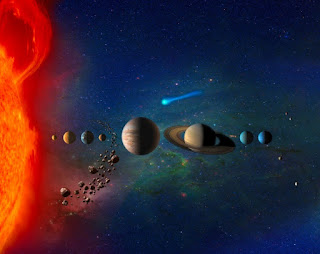The Fearful Symmetry of the Solar System
The title of this post was inspired by the poet William Blake, who could conceivably have been inspired by how God described Leviathan and Behemoth when he wrote "The Tyger". In the last stanza he asked,
Tyger Tyger burning bright,
In the forests of the night:
What immortal hand or eye,
Dare frame thy fearful symmetry?
Taking a much bigger picture, it is evident that the solar system itself is in symmetry. Believers in cosmic evolution sometimes get angry when told that the appearance of design exists because it really was designed.
 |
| Solar system artwork by NASA (usage does not imply endorsement of site contents) |
Another reason secular scientists are confused is because their models do not comport with reality. According to those models, orbits of the four inner planets should have crashed into each other. In fact, they have gravitational influence on each other. Scientists are bright people, but they just don't know as much as they think — especially since they strive to keep God, the Creator and Sustainer, out of the picture.
In researching our solar system, Copernicus (1473-1543) determined that our sun was near the center of our solar system, rather than the Earth itself. Johannes Kepler (1571-1630), implementing his laws of planetary motion, correctly described the orbits of the planets as elliptical paths around the Sun. Fifty years later, another creation scientist, Sir Isaac Newton (1642-1726), used his laws of motion and universal gravitation to explain why these orbits were elliptical.
. . .
A recent article regarding the “remarkable stability of the orbits of the inner planets” was reported in Physical Review X.1 But according to physical models, they should be in a chaotic mess.
The entire article can be seen at "Solar System Symmetries."